jump start Hyundai Santa Fe 2009 Owner's Manual - RHD (UK, Australia)
[x] Cancel search | Manufacturer: HYUNDAI, Model Year: 2009, Model line: Santa Fe, Model: Hyundai Santa Fe 2009Pages: 269, PDF Size: 9.78 MB
Page 15 of 269
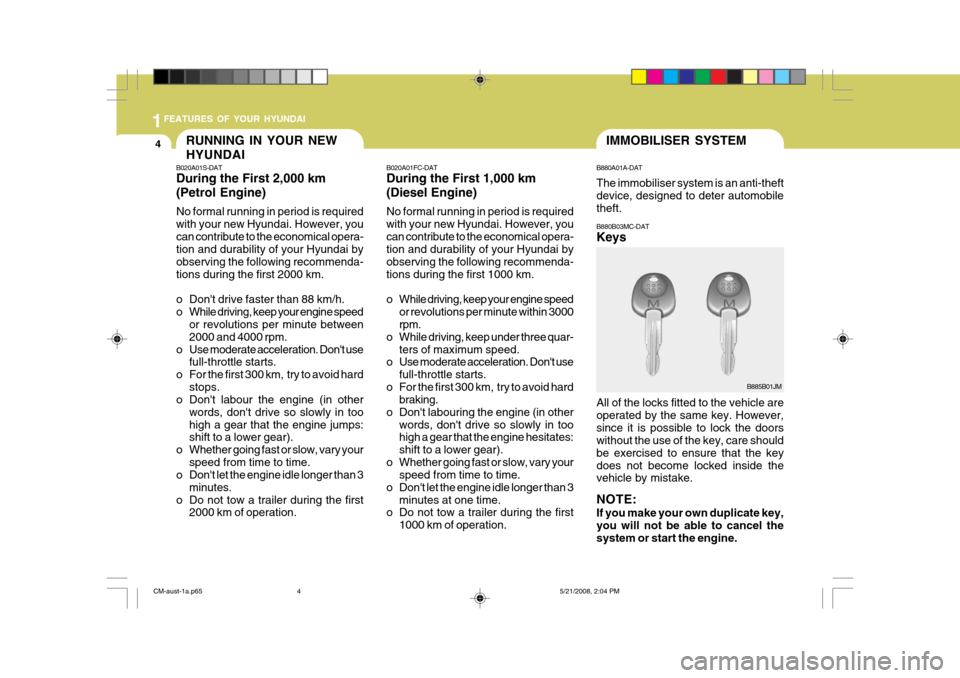
1FEATURES OF YOUR HYUNDAI
4IMMOBILISER SYSTEM
B880A01A-DAT The immobiliser system is an anti-theft device, designed to deter automobile theft. B880B03MC-DAT Keys All of the locks fitted to the vehicle are operated by the same key. However,since it is possible to lock the doors without the use of the key, care should be exercised to ensure that the keydoes not become locked inside the vehicle by mistake. NOTE: If you make your own duplicate key, you will not be able to cancel the system or start the engine.
B885B01JM
B020A01FC-DAT During the First 1,000 km (Diesel Engine) No formal running in period is required with your new Hyundai. However, youcan contribute to the economical opera- tion and durability of your Hyundai by observing the following recommenda-tions during the first 1000 km.
o While driving, keep your engine speed
or revolutions per minute within 3000 rpm.
o While driving, keep under three quar- ters of maximum speed.
o Use moderate acceleration. Don't use
full-throttle starts.
o For the first 300 km, try to avoid hard braking.
o Don't labouring the engine (in other words, don't drive so slowly in toohigh a gear that the engine hesitates: shift to a lower gear).
o Whether going fast or slow, vary your speed from time to time.
o Don't let the engine idle longer than 3
minutes at one time.
o Do not tow a trailer during the first
1000 km of operation.
RUNNING IN YOUR NEW HYUNDAI
B020A01S-DAT During the First 2,000 km (Petrol Engine) No formal running in period is required with your new Hyundai. However, youcan contribute to the economical opera- tion and durability of your Hyundai by observing the following recommenda-tions during the first 2000 km.
o Don't drive faster than 88 km/h.
o While driving, keep your engine speed
or revolutions per minute between2000 and 4000 rpm.
o Use moderate acceleration. Don't use full-throttle starts.
o For the first 300 km, try to avoid hard stops.
o Don't labour the engine (in other
words, don't drive so slowly in toohigh a gear that the engine jumps: shift to a lower gear).
o Whether going fast or slow, vary your speed from time to time.
o Don't let the engine idle longer than 3
minutes.
o Do not tow a trailer during the first 2000 km of operation.
CM-aust-1a.p65 5/21/2008, 2:04 PM
4
Page 163 of 269
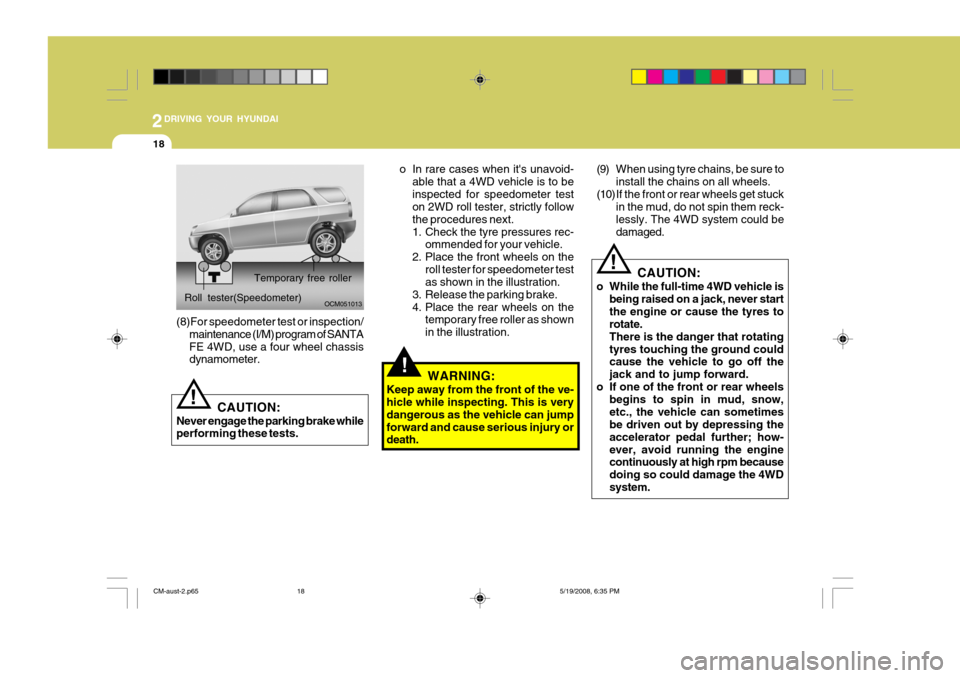
2DRIVING YOUR HYUNDAI
18
!
(9) When using tyre chains, be sure to
install the chains on all wheels.
(10) If the front or rear wheels get stuck
in the mud, do not spin them reck- lessly. The 4WD system could bedamaged.
CAUTION:
o While the full-time 4WD vehicle is being raised on a jack, never startthe engine or cause the tyres torotate.There is the danger that rotatingtyres touching the ground could cause the vehicle to go off the jack and to jump forward.
o If one of the front or rear wheels begins to spin in mud, snow,etc., the vehicle can sometimes be driven out by depressing the accelerator pedal further; how-ever, avoid running the engine continuously at high rpm because doing so could damage the 4WDsystem.
!
WARNING:
Keep away from the front of the ve- hicle while inspecting. This is very dangerous as the vehicle can jumpforward and cause serious injury or death. o In rare cases when it's unavoid-
able that a 4WD vehicle is to be inspected for speedometer test on 2WD roll tester, strictly follow the procedures next.
1. Check the tyre pressures rec-ommended for your vehicle.
2. Place the front wheels on the
roll tester for speedometer test as shown in the illustration.
3. Release the parking brake.
4. Place the rear wheels on the temporary free roller as shownin the illustration.
Roll tester(Speedometer)
(8)For speedometer test or inspection/ maintenance (I/M) program of SANTA FE 4WD, use a four wheel chassis dynamometer.
CAUTION:
Never engage the parking brake whileperforming these tests.
! OCM051013
Temporary free roller
CM-aust-2.p65
5/19/2008, 6:35 PM
18
Page 176 of 269
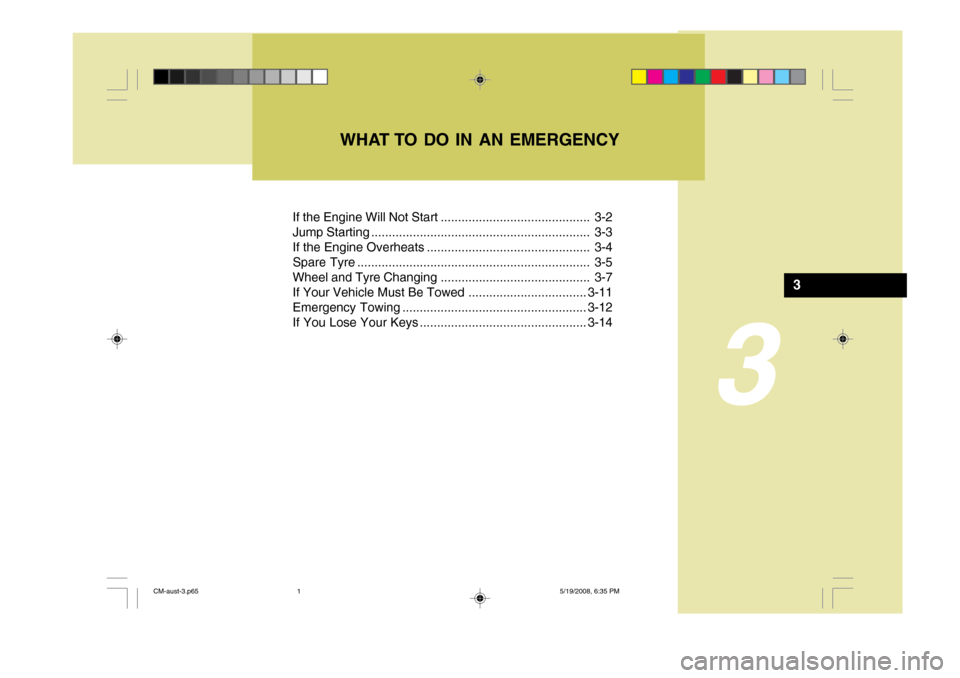
3
If the Engine Will Not Start ........................................... 3-2
Jump Starting ............................................................... 3-3
If the Engine Overheats ............................................... 3-4
Spare Tyre ................................................................... 3-5
Wheel and Tyre Changing ........................................... 3-7
If Your Vehicle Must Be Towed ..................................3-11
Emergency Towing ..................................................... 3-12
If You Lose Your K eys ................................................ 3-14
WHAT TO DO IN AN EMERGENCY
3
CM-aust-3.p65
5/19/2008, 6:35 PM
1
Page 177 of 269
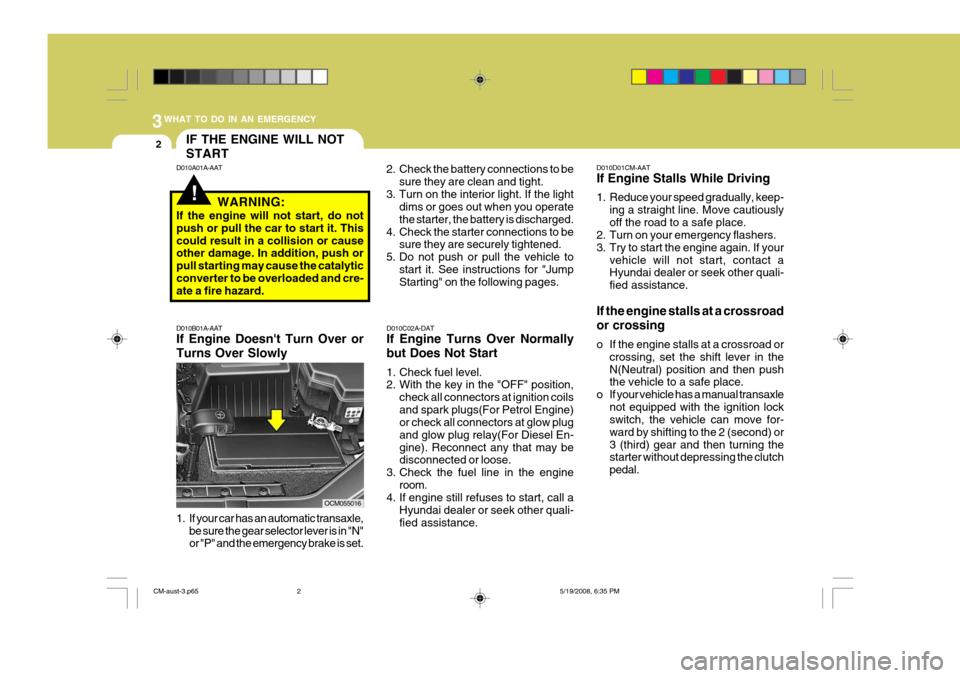
3WHAT TO DO IN AN EMERGENCY
2
!
IF THE ENGINE WILL NOT START
1. If your car has an automatic transaxle, be sure the gear selector lever is in "N" or "P" and the emergency brake is set.
D010B01A-AAT If Engine Doesn't Turn Over or Turns Over Slowly
D010A01A-AAT
D010D01CM-AAT If Engine Stalls While Driving
1. Reduce your speed gradually, keep-
ing a straight line. Move cautiously off the road to a safe place.
2. Turn on your emergency flashers.
3. Try to start the engine again. If your
vehicle will not start, contact a Hyundai dealer or seek other quali- fied assistance.
If the engine stalls at a crossroad or crossing
o If the engine stalls at a crossroad or crossing, set the shift lever in the N(Neutral) position and then push the vehicle to a safe place.
o If your vehicle has a manual transaxle not equipped with the ignition lockswitch, the vehicle can move for- ward by shifting to the 2 (second) or3 (third) gear and then turning the starter without depressing the clutch pedal.
D010C02A-DAT If Engine Turns Over Normally but Does Not Start
1. Check fuel level.
2. With the key in the "OFF" position,
check all connectors at ignition coils and spark plugs(For Petrol Engine) or check all connectors at glow plug and glow plug relay(For Diesel En-gine). Reconnect any that may be disconnected or loose.
3. Check the fuel line in the engine
room.
4. If engine still refuses to start, call a
Hyundai dealer or seek other quali- fied assistance.
WARNING:
If the engine will not start, do notpush or pull the car to start it. Thiscould result in a collision or cause other damage. In addition, push or pull starting may cause the catalyticconverter to be overloaded and cre- ate a fire hazard.
OCM0550162. Check the battery connections to be
sure they are clean and tight.
3. Turn on the interior light. If the light dims or goes out when you operate the starter, the battery is discharged.
4. Check the starter connections to be sure they are securely tightened.
5. Do not push or pull the vehicle to start it. See instructions for "Jump Starting" on the following pages.
CM-aust-3.p65 5/19/2008, 6:35 PM
2
Page 178 of 269
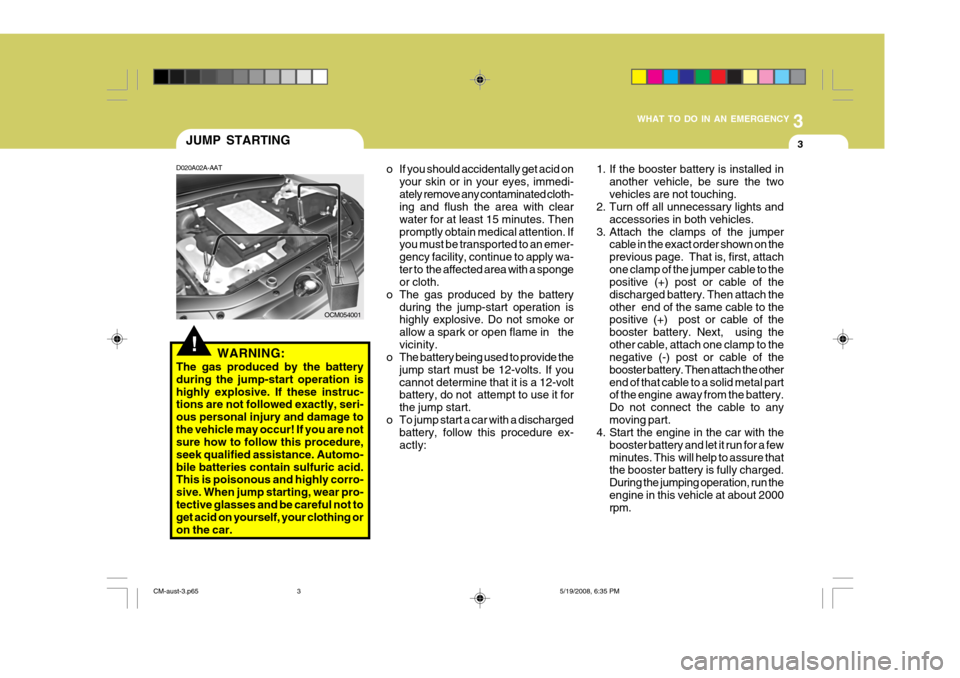
3
WHAT TO DO IN AN EMERGENCY
3
!
OCM054001
JUMP STARTING
D020A02A-AAT
WARNING:
The gas produced by the battery during the jump-start operation ishighly explosive. If these instruc- tions are not followed exactly, seri- ous personal injury and damage tothe vehicle may occur! If you are not sure how to follow this procedure, seek qualified assistance. Automo-bile batteries contain sulfuric acid. This is poisonous and highly corro- sive. When jump starting, wear pro-tective glasses and be careful not to get acid on yourself, your clothing or on the car. o If you should accidentally get acid on
your skin or in your eyes, immedi-ately remove any contaminated cloth- ing and flush the area with clear water for at least 15 minutes. Thenpromptly obtain medical attention. If you must be transported to an emer- gency facility, continue to apply wa-ter to the affected area with a sponge or cloth.
o The gas produced by the battery
during the jump-start operation ishighly explosive. Do not smoke or allow a spark or open flame in thevicinity.
o The battery being used to provide the
jump start must be 12-volts. If youcannot determine that it is a 12-volt battery, do not attempt to use it for the jump start.
o To jump start a car with a discharged battery, follow this procedure ex-actly: 1. If the booster battery is installed in
another vehicle, be sure the twovehicles are not touching.
2. Turn off all unnecessary lights and
accessories in both vehicles.
3. Attach the clamps of the jumper cable in the exact order shown on theprevious page. That is, first, attachone clamp of the jumper cable to the positive (+) post or cable of the discharged battery. Then attach theother end of the same cable to the positive (+) post or cable of the booster battery. Next, using theother cable, attach one clamp to the negative (-) post or cable of the booster battery. Then attach the otherend of that cable to a solid metal part of the engine away from the battery. Do not connect the cable to anymoving part.
4. Start the engine in the car with the
booster battery and let it run for a fewminutes. This will help to assure that the booster battery is fully charged. During the jumping operation, run theengine in this vehicle at about 2000 rpm.
CM-aust-3.p65 5/19/2008, 6:35 PM
3
Page 179 of 269
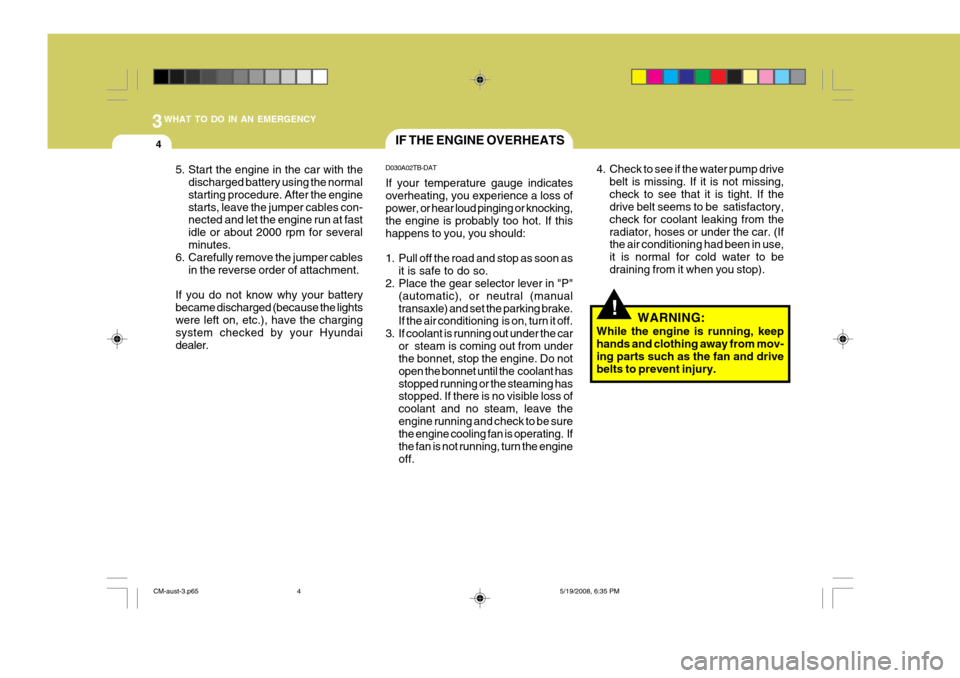
3WHAT TO DO IN AN EMERGENCY
4
!
IF THE ENGINE OVERHEATS
4. Check to see if the water pump drivebelt is missing. If it is not missing, check to see that it is tight. If the drive belt seems to be satisfactory, check for coolant leaking from theradiator, hoses or under the car. (If the air conditioning had been in use, it is normal for cold water to bedraining from it when you stop).
D030A02TB-DAT If your temperature gauge indicates overheating, you experience a loss of power, or hear loud pinging or knocking, the engine is probably too hot. If thishappens to you, you should:
1. Pull off the road and stop as soon as
it is safe to do so.
2. Place the gear selector lever in "P"
(automatic), or neutral (manual transaxle) and set the parking brake. If the air conditioning is on, turn it off.
3. If coolant is running out under the car or steam is coming out from underthe bonnet, stop the engine. Do not open the bonnet until the coolant hasstopped running or the steaming has stopped. If there is no visible loss of coolant and no steam, leave theengine running and check to be sure the engine cooling fan is operating. If the fan is not running, turn the engineoff. WARNING:
While the engine is running, keephands and clothing away from mov-ing parts such as the fan and drive belts to prevent injury.
5. Start the engine in the car with the
discharged battery using the normal starting procedure. After the enginestarts, leave the jumper cables con- nected and let the engine run at fast idle or about 2000 rpm for severalminutes.
6. Carefully remove the jumper cables
in the reverse order of attachment.
If you do not know why your batterybecame discharged (because the lightswere left on, etc.), have the charging system checked by your Hyundai dealer.
CM-aust-3.p65 5/19/2008, 6:35 PM
4
Page 267 of 269
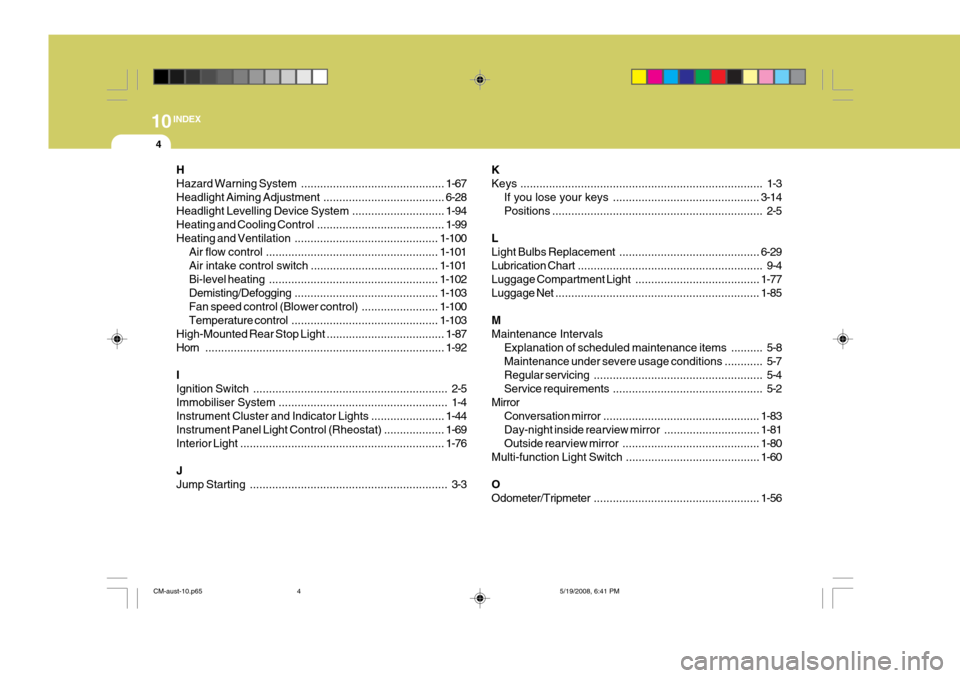
4
10INDEX
H Hazard Warning
System ............................................. 1-67
Headlight Aiming Adjustment ......................................6-28
Headlight Levelling Device System .............................1-94
Heating and Cooling Con trol ........................................ 1-99
Heating and Ventilation ............................................. 1-100
Air flow control ...................................................... 1-101
Air intake control switch ........................................ 1-101
Bi-level heating ..................................................... 1-102
Demisting/Defogging ............................................. 1-103
Fan speed control (Blower control) ........................1-100
Temperature control .............................................. 1-103
High-Mounted Rear Stop Light ..................................... 1-87
Horn ........................................................................... 1-92
IIgnition Switch ............................................................. 2-5
Immobiliser System ..................................................... 1-4
Instrument Cluster and Indicator Lights .......................1-44
Instrument Panel Light Control (Rheostat) ................... 1-69
Interior Light ................................................................ 1-76
JJump Starting .............................................................. 3-3 KKeys
............................................................................ 1-3
If you lose y our keys .............................................. 3-14
Positions .................................................................. 2-5
LLight Bulbs R eplacement............................................ 6-29
Lubrication Chart .......................................................... 9-4
Luggage Compartment Light .......................................1-77
Luggage Net ................................................................ 1-85
MMaintenance Intervals Explanation of scheduled maintenance items .......... 5-8Maintenance under severe usage conditions ............ 5-7
Regular servi cing..................................................... 5-4
Service requ irements............................................... 5-2
Mirror Conversation mirror ................................................. 1-83
Day-night inside rearview mirror .............................. 1-81
Outside rearview mirror ........................................... 1-80
Multi-function Light Switch ................... .......................1-60
OOdometer/Tripmeter .................................................... 1-56
CM-aust-10.p65 5/19/2008, 6:41 PM
4